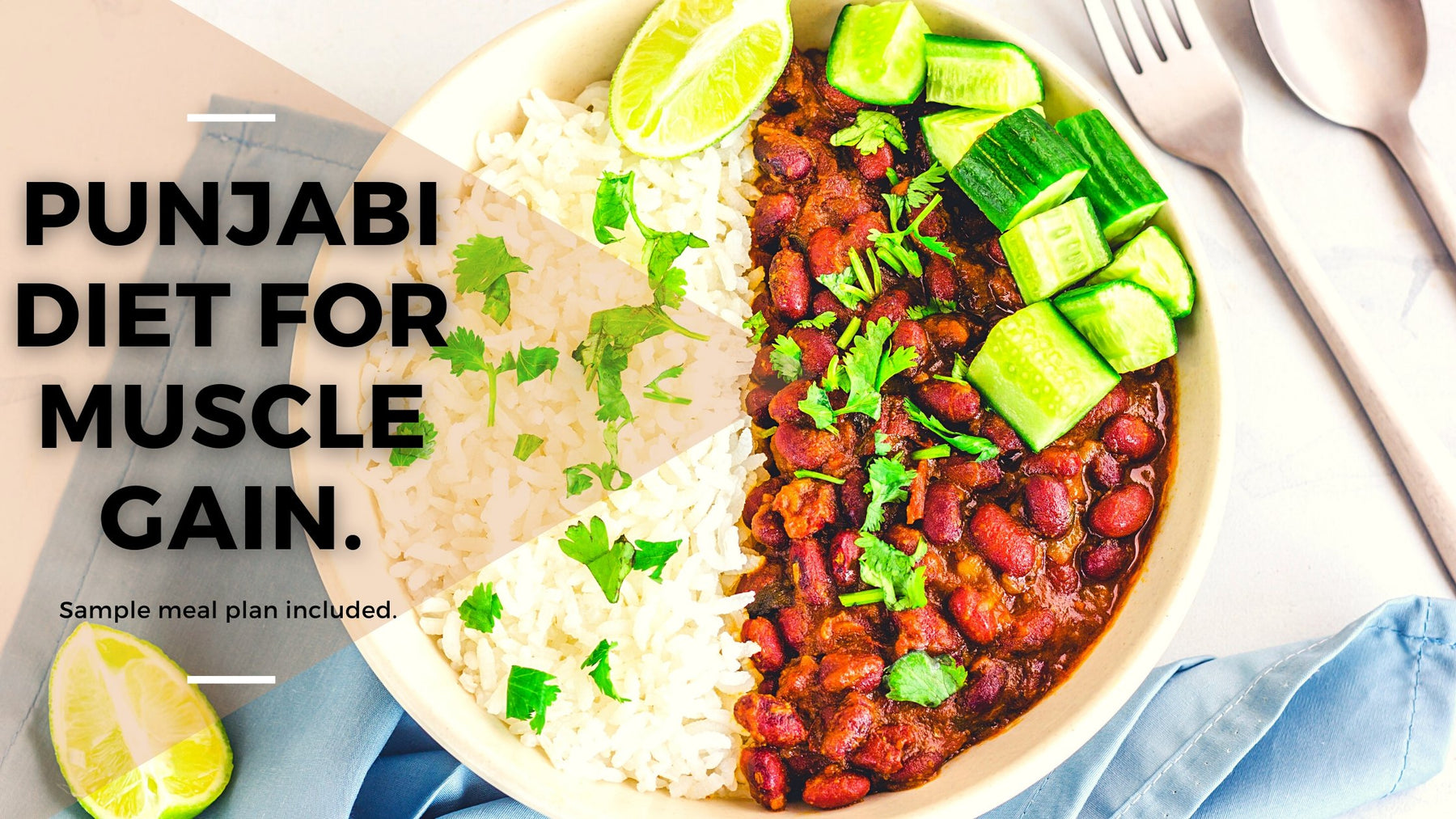
Punjabi Diet Plan For Weight Gain and Bodybuilding.
Table Of Content
I have attached a sample meal plan at the end of this blog. This will make it easy for you to follow along.
People all over India and also outside the subcontinent think that Punjabis are ‘healthy’ (hint: Decent way to say obese). And, why not? After all, Punjab is a robust state, known for its robust farms and rustic food. Any Punjabi dish has high-fat content owing to the presence of milk and meat by-products like ghee and kabab’s. Such products result in a protruding belly or that “tond," as we call it. Our sedentary lifestyle also has a significant role to play.
Do read about Punjabi Diet Plan For Weight Loss!
The assumption about ghee-laden Punjabi food is even partially correct. In fact, the word healthy and Punjabi diet together sounds more like an oxymoron.
Wait, what?! But why!? Because the minute we hear about Punjabi cuisine, we picture aloo paratha dripping with butter and a tall lassi glasses. This is accompanied by thick paneer makhani, creamy dal makhani, butter chicken, and chole bhature.

While no Punjabi would have these foods all at once but these are calorie-filled dishes. Regular consumption of such foods causes weight gain.
But who says you cannot buff up with a traditional Punjabi diet plan? Nutritionally speaking, the constituents of Punjabi diets are sound. If you want to build muscles, you only need to make a few tweaks.
Cut your refined carbohydrates, sugar, and fat, and consume the right macros. Are you wondering how to do that? Read on to find about the right macros and so much more about building muscles by following a Punjabi diet plan. And you will not find the slightest mention of a diet pill or any fad diet in this blog.
Measure your Macros
In the muscle-building world, there are a gazillion diet plans. Some work while some don't. You can count your carbohydrates, or points, or calories. Or, you can walk an extra mile by counting your macros. You must be wondering what are macros and how do we measure them? Well, macros are short for macronutrients and include fats, carbohydrates, and protein.
Therefore, when you count your macros, you count your fat, carbs, and proteins in grams.
Macro counting serves fine because the plan is not one of those one-size-fits-all. Dieticians and nutritionists refer to macros as "flexible dieting." This term means that you will eat all the real foods without depriving your body of anything.
You can eat anything as long as it fits into the macros. Now, do you think you can eat truckloads of chole bhature? Of course not, but can you indulge in it once in a while and still see your muscles getting built? Hell yes!
Counting macros makes you lose the stubborn belly fat and maintains lean muscle mass. Remember, there is no standard for the number of macros you should eat. It differs from person to person. Besides; it also depends on personal goals, age, activity level, weight, and height.
Determine your magic numbers through an online macro-counting calculator. You can also get in touch with a qualified nutritionist.
As per the RDI for muscle gain, try getting 20-25% calories from fats (nuts and seeds), 55-65% calories from carbs (few wholemeal chapattis/ lentils like rajma), and 25-30% from protein (any lentils/ beans/ pulses).
A diet based on macros is conducive to the muscle-building process. Do you know why?
The diet fuels your muscles, and promotes recovery.
Unless fat- loss is your goal, avoid staying in a caloric deficit. Eat 200- 300 calories more than you require.
Top 10 tips for gaining muscle mass
I share 10 tips for gaining muscles by following a vegan Punjabi diet.
1) Meat to gain weight and lose muscles!
If you are on a chicken diet because you feel that meat will give you the best proteins, you are wrong. The real truth is that meat has high-fat content and is calorically density. Meat is also highly acidic and leads to inflammation, thus slowing down recovery. The result is shrunken muscles and inhibited growth.
Therefore the very first tip would be to avoid animal-based diets at all costs. To prevent animal acidosis, avoid meat, dairy, and gorge on alkaline foods. Plant- based protein sources preserve and aid the regeneration of muscle mass. Thus, enjoy a rainbow of meals on your plate!
2) Train correctly and choose the precise training regimen.
Challenge your muscles through the right activities to gain muscle mass. Remember that the training meant for weight maintenance differs from the ones targeted for building muscles.
Subject your muscles to weights and resistance training that causes tearing and building stronger muscles. With progressive overloading, the size and diameter of your muscle fiber increases.
Opt for compound movements that work on multiple joints. Include bench presses, pull-ups, deadlifts, and squats in your muscle-building regimen.
3) Consume healthy calories by relying on plant-based protein sources.
Opt for healthy snacks and have peanut or almond butter with your paranthas. Do not go overboard with excess proteins as it damages bones, burden the liver and kidneys.
You can have your share of 80- 100 grams proteins from Punjabi dishes like masala masoor, chole ki sabzi, or sukhi moong dal ki sabji with rotis.
A delicious meal of 100 g Kala chana cooked with broccoli and sweet potatoes gives you plenty of protein effortlessly! Trust me; you will feel a difference as the plant-based proteins are not as acidic as animal-derived proteins. You can digest them easily and contribute to the synthesis of your muscles.
4) Consume adequate amounts of Omega-3 and healthy fats.
A healthy diet that encompasses several healthy fats is necessary for your muscles. In no way can meat or dairy be a source of your omega-3 or fats. All they can give you is diabetes and severe heart disease.
Aim for 15-20 grams flaxseeds. You can have it in the form of alsi ki pinni or its chutney with your parathas. Flaxseeds also contain omega-3that helps to boost recovery. Try and see if you can add walnuts and chia seeds to your routine too.
5) Set realistic goals.
Do not ever get frustrated if you are not making progress. Do not expect to gain 30 lbs of muscle mass in 60 days or arms of 16inches to 18 inches in two weeks.
Setting unrealistic goals can be demoralising; thus, analyse your goals and set achievable targets. Losing fat is more comfortable than building muscle mass. Therefore expect to gain 2-3 pounds of lean muscle mass every 30-45 days.
6) Abstain from alcohol.
Another thing that has wreaked the Punjabi food scene is alcohol. People forget that alcohol has no nutritional value and gives empty calories. Besides this, alcohol causes hormonal imbalance and damages your gut microbiome. Both of which are detrimental to your progress.
You can have a faulty liver and multiple cardiovascular diseases from the daaru. If you want to see muscle growth and flaunt those manly packs, then bid farewell to alcohol right away.
7) No smoking.
Smoking boosts the AMP-activated protein kinase activity and increases the AGE’s. Not only do these lead to weight loss, but also cause oxidation and excessive inflammation that destroys your muscle process. Hence, bury that cigarette today onwards.
8) Stop stressing.
Excess stress shoots the cortisol levels in your body. You must know that this hormone hates muscles and loves fat. Therefore, while lifting weights, focus on gradual overloading.
On the very first day, if you jump off to lifting 50 kilograms straight, then cortisol levels will rise in your body. Lower your cortisol levels by practicing breathing exercises and practicing mindfulness.
9) Get plenty of rest.
Rest is critical if you want to recover from exercise-induced stress. The cortisol levels increase when you do not rest, and the glycogen levels deplete.
When your body is not replenished, your muscles experience fatigue and soreness. Therefore opt for undisturbed sleep of seven hours at least to build muscles.
10. Maintain a food journal.
When you fail to plan, you plan to fail. Thus, if you are not maintaining a daily food journal, you are committing a mistake. When building muscles, you cannot afford to have a calorie deficit. Hence write down the calories you consume, prep your meals, and plan diets accordingly.
Sample Meal Plan for one week.

FAQs
What is so special about Punjabi food?
The most remarkable thing about Punjabi food is that a section of its cuisine is vegan by default. You can try out the best dishes in gravy made of watermelon seeds, cashews, or almond paste. For instance, you can have the vegetable makhanwala without adding dairy products. You can have the spicy and tasty masala masoor and green pulav. A simple tandoori vegetable dish tastes far better than a paneer tikka or butter chicken, any day!
What is the main food of Punjabi?
Punjab's principal food that rules millions of hearts includes the sarson the saag (a stew of mustard greens) and Makki di roti (cornmeal flatbreads). However, the staple diet of an average Punjabi is roti sabzi or the quintessential daal roti. This is because Punjab is a significant wheat and lentil producer.
What is the famous vegetarian dish in Punjab?
The famous vegetarian dish of Punjab is Sarson da saag, besides many others.
Can Punjabi food be tasty and still healthy?
Yes, Punjabi food can be tasty and healthy at the same time. It all depends on the way you are making the dish. For instance, whole wheat paranthe without ghee and butter is great for your muscles growth. And, so is a plate of warm rajma chawal!
In conclusion...
Big muscles comes with dedication and discipline. To build them, you must ditch the dairy and meat because it simply causes metabolic acidosis. The result is long term downfall in health.
Opt for a plant-based alkaline diet like kaali daal, sprouted moong, chole, and saag. Trust me, the small changes in your diet and committing to the targets can make you achieve your goals.
Use a kitchen scale to measure your nutrients, record protein intake, prep your meals and track your calories. Work hard, and train well, you will be there in no time.
Fill out this form below if you want me to design your diet chart as per your body type.
Let's Just Talk. No Obligations.
I do free consultations every Tuesday's and Thursday's. Either way you will get some actionable tips to reach your fitness goals faster.


Leave a comment